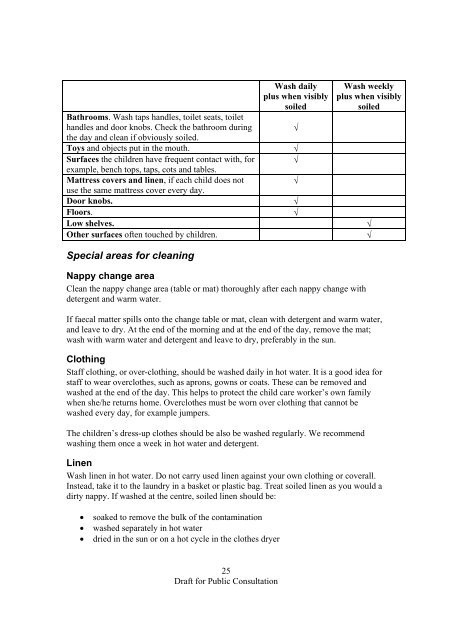Staying Healthy in Child Care - National Health and Medical ...
Staying Healthy in Child Care - National Health and Medical ...
Staying Healthy in Child Care - National Health and Medical ...
Create successful ePaper yourself
Turn your PDF publications into a flip-book with our unique Google optimized e-Paper software.
Bathrooms. Wash taps h<strong>and</strong>les, toilet seats, toilet<br />
h<strong>and</strong>les <strong>and</strong> door knobs. Check the bathroom dur<strong>in</strong>g<br />
the day <strong>and</strong> clean if obviously soiled.<br />
25<br />
Draft for Public Consultation<br />
Wash daily<br />
plus when visibly<br />
soiled<br />
√<br />
Wash weekly<br />
plus when visibly<br />
soiled<br />
Toys <strong>and</strong> objects put <strong>in</strong> the mouth. √<br />
Surfaces the children have frequent contact with, for<br />
example, bench tops, taps, cots <strong>and</strong> tables.<br />
√<br />
Mattress covers <strong>and</strong> l<strong>in</strong>en, if each child does not<br />
use the same mattress cover every day.<br />
√<br />
Door knobs. √<br />
Floors. √<br />
Low shelves. √<br />
Other surfaces often touched by children. √<br />
Special areas for clean<strong>in</strong>g<br />
Nappy change area<br />
Clean the nappy change area (table or mat) thoroughly after each nappy change with<br />
detergent <strong>and</strong> warm water.<br />
If faecal matter spills onto the change table or mat, clean with detergent <strong>and</strong> warm water,<br />
<strong>and</strong> leave to dry. At the end of the morn<strong>in</strong>g <strong>and</strong> at the end of the day, remove the mat;<br />
wash with warm water <strong>and</strong> detergent <strong>and</strong> leave to dry, preferably <strong>in</strong> the sun.<br />
Cloth<strong>in</strong>g<br />
Staff cloth<strong>in</strong>g, or over-cloth<strong>in</strong>g, should be washed daily <strong>in</strong> hot water. It is a good idea for<br />
staff to wear overclothes, such as aprons, gowns or coats. These can be removed <strong>and</strong><br />
washed at the end of the day. This helps to protect the child care worker’s own family<br />
when she/he returns home. Overclothes must be worn over cloth<strong>in</strong>g that cannot be<br />
washed every day, for example jumpers.<br />
The children’s dress-up clothes should be also be washed regularly. We recommend<br />
wash<strong>in</strong>g them once a week <strong>in</strong> hot water <strong>and</strong> detergent.<br />
L<strong>in</strong>en<br />
Wash l<strong>in</strong>en <strong>in</strong> hot water. Do not carry used l<strong>in</strong>en aga<strong>in</strong>st your own cloth<strong>in</strong>g or coverall.<br />
Instead, take it to the laundry <strong>in</strong> a basket or plastic bag. Treat soiled l<strong>in</strong>en as you would a<br />
dirty nappy. If washed at the centre, soiled l<strong>in</strong>en should be:<br />
• soaked to remove the bulk of the contam<strong>in</strong>ation<br />
• washed separately <strong>in</strong> hot water<br />
• dried <strong>in</strong> the sun or on a hot cycle <strong>in</strong> the clothes dryer
















